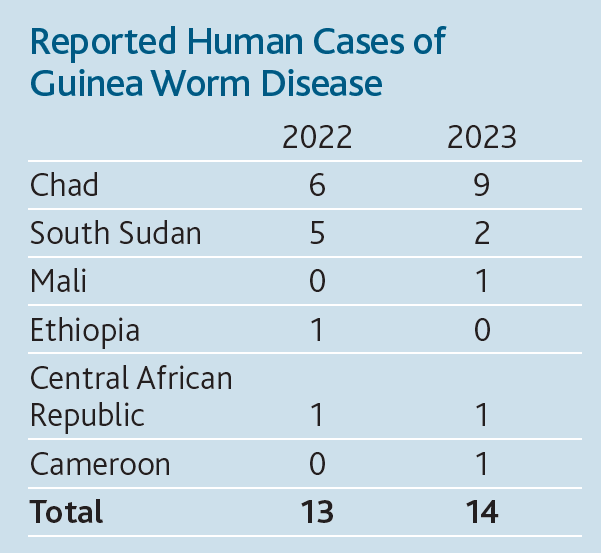Humankind has been battling Guinea worm disease for millennia, and since the 1980s, The Carter Center has been leading the charge to rid the world of this parasite. Incredible progress has been made in recent decades.

Fourteen human cases and 726 infections in animals were reported in 2023, both slight increases from the previous year, when there were 13 human cases and 683 animal infections.
“This doesn’t necessarily mean the worm population is growing,” said Adam Weiss, director of the Center’s Guinea Worm Eradication Program. “It means we’re getting better at finding them.”
Weiss cited expanded surveillance and reporting in Angola, where Guinea worms have appeared only recently, and Cameroon, where infections spill over from Chad.
Nine of the 14 human cases reported in 2023 occurred in Chad, two in South Sudan and one each in Cameroon, Mali, and the Central African Republic. Ethiopia reported zero human cases.
When The Carter Center assumed leadership of the global eradication campaign in 1986, an estimated 3.5 million human cases were occurring every year.
To encourage reporting of cases and animal infections, people in impacted locations are paid cash rewards for reporting confirmed Guinea worms. Health workers aggressively investigate all such rumors, which are key to finding actual cases and infections.
Carter Center CEO Paige Alexander met a Guinea worm patient and observed interventions in action during a rain-soaked April 2023 visit she and Board of Trustees member Dr. Greg Vaughn made to Adeba, South Sudan.
“The hard work being done here and in the other endemic countries is so important,” Alexander said during the visit. “This is how we’re going to eradicate Guinea worm — one rumor, one person, one village at a time.”
Guinea worm disease is typically contracted when people or certain animals drink water containing tiny crustaceans (called copepods or water fleas) that harbor Guinea worm larvae. The larvae mature into worms and mate within the human or animal host. The male worm dies. After about a year, a meter-long pregnant female worm emerges slowly through a painful blister in the skin, often of the legs or feet (but it could be anywhere). A sufferer may seek relief by dipping the affected body part in water. Unfortunately, contact with water stimulates the emerging worm to release its larvae and start the life cycle anew. Guinea worm disease incapacitates people for weeks or months — sometimes permanently — reducing individuals’ ability to care for themselves, work, grow food for their families, or attend school.
Without a vaccine or medicine, the disease is being eradicated mainly through community-based interventions to educate people and change their behavior.
“The volunteers and program officers are the backbone of the surveillance system in areas beyond the end of the road, where Guinea worm disease is making its last stand,” Alexander said in South Sudan.
In addition to education, interventions to stop transmission include the use of filters (donated by Vestergaard’s LifeStraw®) for all drinking water, barring people and animals with emerging Guinea worms from entering water sources, and targeted use of the larvicide ABATE® (donated by BASF) in thousands of stagnant, shallow water sources.
Tethering dogs to keep them out of water and not allowing them to eat potentially contaminated fish entrails are key factors in preventing Guinea worm infection in animals.
With continued interventions and alert surveillance, the Guinea worm will soon run out of places to hide.
Related Resources
Please sign up below for important news about the work of The Carter Center and special event invitations.